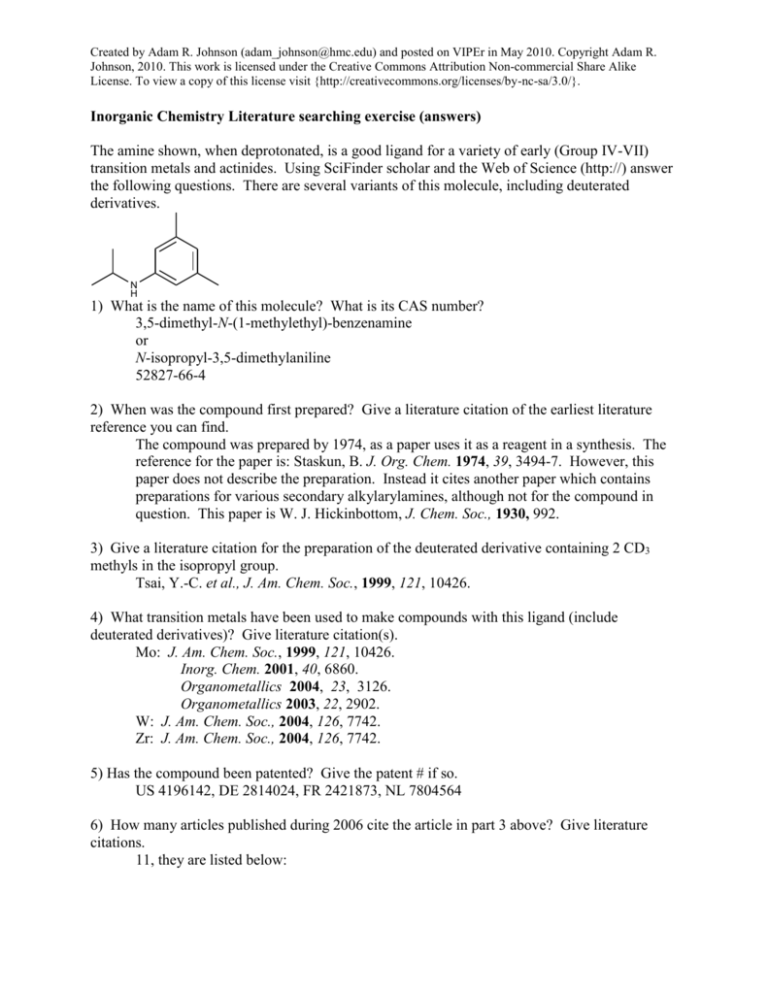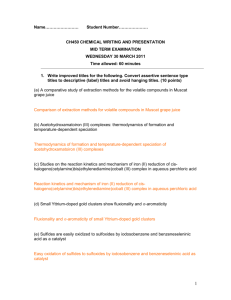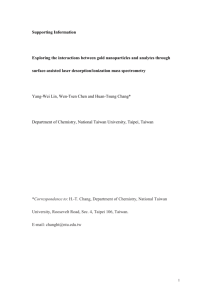SciFinder exercise
advertisement

Created by Adam R. Johnson (adam_johnson@hmc.edu) and posted on VIPEr in May 2010. Copyright Adam R.
Johnson, 2010. This work is licensed under the Creative Commons Attribution Non-commercial Share Alike
License. To view a copy of this license visit {http://creativecommons.org/licenses/by-nc-sa/3.0/}.
Inorganic Chemistry Literature searching exercise (answers)
The amine shown, when deprotonated, is a good ligand for a variety of early (Group IV-VII)
transition metals and actinides. Using SciFinder scholar and the Web of Science (http://) answer
the following questions. There are several variants of this molecule, including deuterated
derivatives.
N
H
1) What is the name of this molecule? What is its CAS number?
3,5-dimethyl-N-(1-methylethyl)-benzenamine
or
N-isopropyl-3,5-dimethylaniline
52827-66-4
2) When was the compound first prepared? Give a literature citation of the earliest literature
reference you can find.
The compound was prepared by 1974, as a paper uses it as a reagent in a synthesis. The
reference for the paper is: Staskun, B. J. Org. Chem. 1974, 39, 3494-7. However, this
paper does not describe the preparation. Instead it cites another paper which contains
preparations for various secondary alkylarylamines, although not for the compound in
question. This paper is W. J. Hickinbottom, J. Chem. Soc., 1930, 992.
3) Give a literature citation for the preparation of the deuterated derivative containing 2 CD3
methyls in the isopropyl group.
Tsai, Y.-C. et al., J. Am. Chem. Soc., 1999, 121, 10426.
4) What transition metals have been used to make compounds with this ligand (include
deuterated derivatives)? Give literature citation(s).
Mo: J. Am. Chem. Soc., 1999, 121, 10426.
Inorg. Chem. 2001, 40, 6860.
Organometallics 2004, 23, 3126.
Organometallics 2003, 22, 2902.
W: J. Am. Chem. Soc., 2004, 126, 7742.
Zr: J. Am. Chem. Soc., 2004, 126, 7742.
5) Has the compound been patented? Give the patent # if so.
US 4196142, DE 2814024, FR 2421873, NL 7804564
6) How many articles published during 2006 cite the article in part 3 above? Give literature
citations.
11, they are listed below:
Created by Adam R. Johnson (adam_johnson@hmc.edu) and posted on VIPEr in May 2010. Copyright Adam R.
Johnson, 2010. This work is licensed under the Creative Commons Attribution Non-commercial Share Alike
License. To view a copy of this license visit {http://creativecommons.org/licenses/by-nc-sa/3.0/}.
1. Bradley, C. A.; Veiros, L. F.; Pun, D.; Lobkovsky, E.; Keresztes, I.; Chirik, P. J.
“Carbon-Oxygen Bond Cleavage with 9-5-Bis(indenyl)zirconium Sandwich
Complexes.” J. Am. Chem. Soc. 2006, 128, 16600-16612
2. Kilgore, U. J.; Yang, X.; Tomaszewski, J.; Huffman, J. C.; Mindiola, D. J. “Activation of
Atmosptheric Nitrogen and Azobenzene N:N Bond Cleavage by a Transient Nb(III)
Complex.” Inorg. Chem., 2006, 45, 10712-10721
3. Seymore, S. B.; Brown, S. N., "Kinetic effects in heterometallic dinitrogen cleavage."
Inorganic Chemistry 2006, 45, (23), 9540-9550.
4. Christian, G. J.; Stranger, R.; Yates, B. F., "Optimizing small molecule activation and
cleavage in three-coordinate M[N(R)Ar](3) complexes." Inorganic Chemistry 2006, 45,
(17), 6851-6859.
5. McDonough, J. E.; Weir, J. J.; Sukcharoenphon, K.; Hoff, C. D.; Kryatova, O. P.; RybakAkimova, E. V.; Scott, B. L.; Kubas, G. J.; Mendiratta, A.; Cummins, C. C.,
"Comparison of thermodynamic and kinetic aspects of oxidative addition of PhE-EPh (E
= S, Se, Te) to Mo(CO)(3)(PR3)(2), W(CO)(3)(PR3)(2), and Mo(N[Bu-t]Ar)(3)
complexes. The role of oxidation state and ancillary ligands in metal complex induced
chalcogenyl radical generation." Journal of the American Chemical Society 2006, 128,
(31), 10295-10303.
6. Gdula, R. L.; Johnson, M. J. A., "Highly active molybdenum-alkylidyne catalysts for
alkyne metathesis: Synthesis from the nitrides by metathesis with alkynes." Journal of the
American Chemical Society 2006, 128, (30), 9614-9615.
7. Fout, A. R.; Basuli, F.; Fan, H. J.; Tomaszewski, J.; Huffman, J. C.; Baik, M. H.;
Mindiola, D. J., "A Co2N2 diamond-core resting state of cobalt(I): A three-coordinate
Co-I synthon invoking an unusual pincer-type rearrangement." Angewandte ChemieInternational Edition 2006, 45, (20), 3291-3295.
8. Figueroa, J. S.; Cummins, C. C., "A niobaziridine hydride system for white phosphorus
or dinitrogen activation and N- or P-atom transfer." Dalton Transactions 2006, (18),
2161-2168.
9. Mendiratta, A.; Cummins, C. C.; Kryatova, O. P.; Rybak-Akimova, E. V.; McDonough,
J. E.; Hoff, C. D., "Benzonitrile extrusion from molybdenum(IV) ketimide complexes
obtained via radical C-E (E = O, S, Se) bond formation: Toward a new nitrogen atom
transfer reaction." Journal of the American Chemical Society 2006, 128, (14), 4881-4891.
10. Figueroa, J. S.; Piro, N. A.; Clough, C. R.; Cummins, C. C., "A nitridoniobium(V)
reagent that effects acid chloride to organic nitrile conversion: Synthesis via
heterodinuclear (Nb/Mo) dinitrogen cleavage, mechanistic insights, and recycling."
Journal of the American Chemical Society 2006, 128, (3), 940-950.
11. Brayshaw, S. K.; Green, J. C.; Kociok-Kohn, G.; Sceats, E. L.; Weller, A. S., "A rhodium
complex with one (RhC)-C-...-C and one (RhH)-H-...-C agostic bond." Angewandte
Chemie-International Edition 2006, 45, (3), 452-456.





